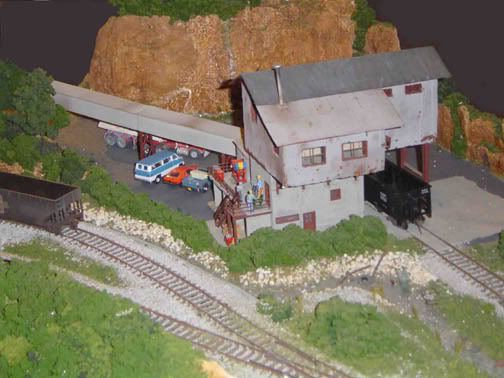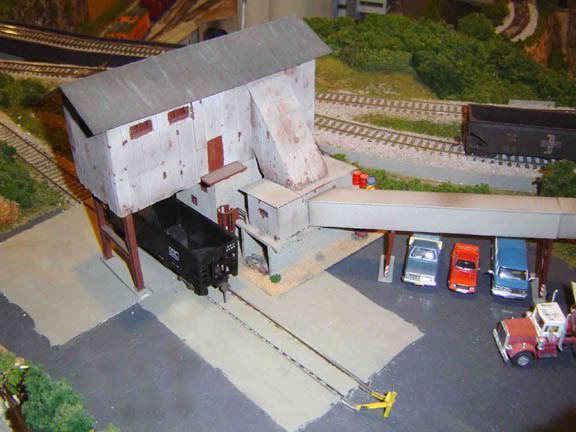Hi
I have some model roofing to do and was wondering what is the current “state of the art” for representing corrugated iron sheet.
Thanks
Chris Waring.
Hi
I have some model roofing to do and was wondering what is the current “state of the art” for representing corrugated iron sheet.
Thanks
Chris Waring.
Chris,
A couple of different things for corregated sheet roofing.
I am in HO, but the plastic sheets of corregated roofing at my LHS, for HO, looked too large. (They carry both Evergreen and Plastruct rather mixed together, so not sure which it was.) However, the N scale looked much better to my eye. Cut the sheet to cover the entire roof. Then, using a pencil, I drew in the lines to represent the sheets. Drew the verticle lines first, about 30" apart, then decided on what length sheets were used and drew the cross lines, offset. Most roofing comes in sheets 8’ to 16’ long, in 2’ increments. If you want to be really accurate, don’t forget an overlap. I then weathered each sheet, with one or two showing considerably more rust.
The first method I tried was taking a long, but small diameter machine bolt, with threads spaced about as I thought they should be and aluminum foil. I cut a strip of foil to width, then holding the bolt in one hand and holding the foil against the threads with my thumb, pulled the foil over the threads. The strips were then cut to length and weathered as necessary. I didn’t try to attach these to a roof, didn’t think they looked quite good enough, however, all was not lost, they will make good added scenery where a roof has been replaced, to cover a wood pile or in a scrap load.
A method I will try next time to get individual sheets is to press foil onto a ribbon cable from an old computer. Didn’t have one on hand the first time around. The curling caused by dragging over the bolt was my main problem, as when I tried to flatten the sheets, I often smoothed out the corregations. By pressing flat against the ribbon, the problem may be lessened.
Just a couple of ideas.
Good luck,
Richard
Hi Chris,
Miceo-Mart offers corrugated sheet aluminum that can be cut with scissors .
http://www.micromark.com/corrugated-aluminum-sheet-030-inch-spacing,9294.html
Maybe this is what you are looking for.
Good luck
Bob
I messed around with foil, and the best results came from pressing the foil over a piece of roofing panel, left over from a Walthers kit, or a piece of wall or roof panel from a Pikestuff kit will work to. I never actually roofed anything with it, but the experiment did produce some nice looking roof panels, which could be used for wall panels too.
Mike.
LION uses ribbon wire from the computer. Surely you have stacks of old computers around with this sort of ribbon wire in them, if not the kid next door surely does have them for you. They will also make good roll up doors and walkways of the sort used on the subway. Here as a picture of this wire used as a corrugated wall at the Dyckman Street station.

I used silicone caulk to adhere the material, but that cannot be painted very well, but then enough paint is peeling off of the actual wall at Dyckman Street that it works out almost perfectly.
ROAR
I’m hardly one to comment on state-of-the-art, but what you’re planning to build may have some bearing on material selection. For large structures, such as steel mills, etc., Evergreen styrene sheets might be the best choice. It’s easy to use and allows quick construction and a neat finished appearance (well, that depends somewhat on your abilities, too [swg]).
For smaller structures, or those less well-maintained, Campbell’s aluminum sheet material does a nice job.
I usually build the sub-roof (does that make me a sub-roofer?) from .060" sheet styrene, braced as necessary, then add the corrugated sheets using contact cement, although it’s also possible to do a modelled framed-roof, and apply the sheets directly atop that.
You can apply the Campbell sheets as they come (4’, 6’, 8’, 10’, and 12’HO lengths, in pieces about 7" long) or you can cut the sheets into individual panels. While using full sheets is faster and looks neater (like a well-done roofing job should look), many opt to apply the sheets as individual pieces, and then overdo the “older roof” look.
Application of full sheets is very simple: you can use a pencil to mark the sub-roof to aid alignment, then use a suitably-sized brush to apply contact cement to both surfaces. I prefer gelled contact cement (Weldbond and LePages offer it, and perhaps others), as it’s much less stringy than the liquid stuff. However, the smallest amount I’ve been able to find is a quart can, enough to do a lot of roofs. It is, however, useful for a lot of other household tasks.
Allow the cement to dry as directed on the can, then, starting at the eaves (bottom) carefully lay each sheet in place. Bonding occurs, not surprisingly, on contact, and you may wish to place a sheet of waxed paper between the roof and the aluminum material to allow you to line things up, then, slowly withdraw the waxed paper and gentl
Consider printed paper textures like those sold by Clever Models. http://clevermodels.squarespace.com/ While they are not 3 dimensional, they look very good. They can be used in one piece or cut into individual sheets and layered.
At a train show I attended many people did not believe that many of the buildings on an O scale layout were made from paper textures without actually touching them.
Hi Chris:
I am going to vote for Evergreen Scale Models styrene corrugated panels. They are available in 6" x 12" or 12" x 24", and they are available in various groove widths. The roofing for smaller buildings would have a corrugation of about 2 3/4" peak to peak, which is about .030" in HO, and Evergreen offers a sheet with .030" spacing.
http://www.evergreenscalemodels.com/Sheets.htm#Corrugated%20Metal%20Siding
Obviously the styrene sheets will produce a smooth roof i.e. none of the sheets will appear to be loose. Whether or not you want to have some of the panels lifting is a personal choice, but if you look at old, weathered corrugated roofs you see that most of the roof is relatively smooth. Here is a view of the East Broad Top RR car shop and other buildings. I don’t believe the roofs have been restored (correct me if I am wrong please). They are many decades old.
http://www.spikesys.com/Bin/EBT/07017.jpg
There may be a panel or two that has torn off but most of the sheets will not be sticking up in the wind. The reality is that once a panel pops loose it will fatigue fairly quickly from rattling in the wind and it will tear off not too long after. You will rarely see a bunch of half loose sheets, certainly not most of the roof as some modellers choose to do. The exception would be a roof that has just gone through a major storm i.e. a hurricane.
If you do want a couple of loose or torn off panels it can still be done with a corrugated styrene roof. Choose where you want the roof damage and cut out a piece of the styrene about 1/4" larger than the damaged area. Take a piece of heavy duty aluminium foil and tape it over an unused section of corrugated roofing and use your finger nail or a pencil to push the foil down into the grooves. That will create a matching roo
I used the Cambell sheets cut to size to cover the gravel loader. It started as a Model Power coal tipple, I bought because I thought from the catalog picture that it was corrugated metal, but it was log cabin style. The only problem I had ws getting th paint to stay stuck to the metal, it kept flaking off as I handled the model.


The conveyor in the bottom photo is covered in Evergreen corrugated sheet
Hi. Thanks for all your replies. I think I am going to be going with the Campbell sheet. To address the paint issue I will prime the cut sheet with an acid etch primer made for spraying aluminium cars.
Thanks again.
Chris.
You also might want to take a look at the product from Rusty Stumps. Compared to the manufacturers offering thin strips of material, Rusty’s 5"x7" sheet can cover a lot more ground. The price is better, as well, about $15 for a pack of 5 sheets. I’m working on a project now covering 25"x25" (40,000 square feet in HO!) and I’m finding it reasonably easy to work with.
